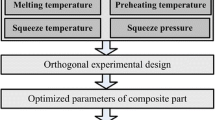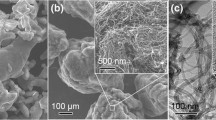Abstract
Two-dimensional Cf/Al composites were fabricated by liquid-solid extrusion following vacuum infiltration technique (LSEVI), and defects were studied and analyzed through optical microscope (OM), scanning electron microscope (SEM), transmission electron microscope(TEM), and the tests of ultimate tensile strength (UTS). Through research, it was found that gas impurities were the main factors to generate hole defects within the 2D-Cf/Al composites, so vacuum level of the test system should be higher than 0.09 MPa. The infiltration of composites would not be sufficient and uniform under the low squeeze pressure of 50 MPa and low squeeze temperature of 590 °C. However, when squeeze pressure was larger than 90 MPa, fiber damage appeared, and macro internal cracks even occurred if it was over 100 MPa. Poor tensile behavior of composites between carbon fibers and matrix might arise because of the inappropriate process parameters. Brittle tensile fracture of composites was observed under the higher preform preheating temperature of 640 °C, and Al4C3 was found. Separated fibers and aluminum alloy of tensile fracture might occur under the lower preheating temperature of 580 °C. These defects hindered the improvement of property of Cf/Al composites greatly, and they should be avoided. Through contrast of UTS, internal cracks and poor tensile behavior were the most detrimental factors. Their UTSs were 45 and 117 MPa, respectively, which were less than 120 MPa of matrix. Improved process parameters were used to prepare the 2D-Cf/Al composite, and its defects were seldom found, so UTS of composite was improved 93.3 % than that of matrix.
Similar content being viewed by others
References
Ma YQ, Qi LH, Zheng WQ, Zhou JM, Ju LY (2013) Effect of specific pressure on fabrication of 2D-Cf/Al composite by pressure infiltration technique. Trans Nonferrous Met Soc China 23(7):1915–1921
Liu J, Qi LH, Guan JT, Ma YQ, Zhou JM (2012) Compressive behavior of Csf/AZ91D composites by liquid–solid extrusion directly following vacuum infiltration technique. Mater Sci Eng A 531:164–170
Qi LH, Su LZ, Jiang CX, Zhou JM, Li HJ (2007) Research on the numerical simulation of liquid-infiltration-extrusion process for composites based on the rigid-viscoplastic FEM. Mater Sci Eng A 454:608–613
Qi LH, Su LZ, Zhou JM, Guan JT, Hou XH, Li HJ (2012) Infiltration characteristics of liquid AZ91D alloy into short carbon fiber preform. J Alloys Compd 527:10–15
Hajjari E, Divandari M, Mirhabibi AR (2010) The effect of applied pressure on fracture surface and tensile properties of nickel coated continuous carbon fiber reinforced aluminum composites fabricated by squeeze casting. Mater Des 31:2381–2386
Jahangir K, Mohammad KBG, Mohsen B, Abbas R (2014) Microstructural, mechanical, and thermophysical characterization of Cu/WC composite layers fabricated via friction stir processing. Int J Adv Manuf Technol 74:1087–1096
Xu WF, Liu JH, Chen DL, Luan GH (2014) Low-cycle fatigue of a friction stir welded 2219-T62 aluminum alloy at different welding parameters and cooling conditions. Int J Adv Manuf Technol 74(1-4):209–218
Daoud A (2005) Microstructure and tensile properties of 2014 Al alloy reinforced with continuous carbon fibers manufactured by gas pressure infiltration. Mater Sci Eng A 391:114–120
Wei S, Li Y, Wang J, Liu K, Zhang P (2014) Microstructure and joining mechanism of Ti/Al dissimilar joint by pulsed gas metal arc welding. Int J Adv Manuf Technol 70:1137–1142
Asadi P, Faraji G, Besharati MK (2010) Producing of AZ91/SiC composite by friction stir processing. Int J Adv Manuf Technol 51:247–260
Arora HS, Singh H, Dhindaw BK (2012) Composite fabrication using friction stir processing—a review. Int J Adv Manuf Technol 61:1043–1055
Yang QR, Liu JX, Li SK, Wang FC, Wu TT (2014) Fabrication and mechanical properties of Cu-coated woven carbon fibers reinforced aluminum alloy composite. Mater Des 57:442–448
Zhang YH, Wu GH (2010) Interface and thermal expansion of carbon fiber reinforced aluminum matrix composites. Trans Nonferrous Met Soc China 20(11):2148–2151
Paolo F, Tyler C, Marco C, Patrick S, Luciano D (2010) Defect and damage analysis of advanced discontinuous carbon/epoxy composite materials. Compos Part A-Appl S 41(7):888–901
Anitha S, John TD, Natarajan TS (2011) A study on defect controlled morphology of organic/inorganic composite nanofibers with different heat flow rates. Mater Lett 65(2):167–170
Clyne TW, Mason JF (1987) Squeeze infiltration process for fabrication of metal-matrix composites. Metall Mater Trans A 18(8):1519–1530
Sommer JL, Mortensen A (1996) Forced unidirectional infiltration of deformable porous media. J Fluid Mech 311:193–217
Seong HG, Lopez HF, Robertson DP, Rohatgi PK (2008) Interface structure in carbon and graphite fiber reinforced 2014 aluminum alloy processed with active fiber cooling. Mater Sci Eng A 487:201–209
Michaud VJ, Sommer JL, Mortensen A (1999) Infiltration of fibrous preforms by a pure metal: part V. Influence of preform compressibility. Metall Mater Trans A 30(2):471–482
Chen N, Pan XF, Gu MY (2009) Microstructure and physical properties of Al/diamond composite fabricated by pressureless infiltration. Mater Sci Technol 25(3):400–402
Naji H, Zebarjad SM, Sajjadi SA (2008) The effects of volume percent and aspect ratio of carbon fiber on fracture toughness of reinforced aluminum matrix composites. Mater Sci Eng A 486:413–420
Woei SL, Wu CS (2000) Dynamic impact and fracture behaviour of carbon fiber reinforced 7075 aluminum metal matrix composite. J Compos Mater 34(21):1821–1840
Yue HY, Wang LD, Fei WD (2009) Effect of ZnO coating of whiskers on thermal expansion properties of aluminium borate whisker reinforced aluminium composites. Mater Sci Technol 25(8):1035–1038
Antonino V, Vincenzo F, Livan F (2011) Mechanical behaviour and failure modes of metal to composite adhesive joints for nautical applications. Int J Adv Manuf Technol 53:593–600
Author information
Authors and Affiliations
Corresponding author
Rights and permissions
About this article
Cite this article
Ma, Y.Q., Qi, L.H., Zhang, T. et al. Study on defects of 2D-Cf/Al composite prepared by liquid-solid extrusion following vacuum infiltration technique. Int J Adv Manuf Technol 88, 89–96 (2017). https://doi.org/10.1007/s00170-016-8768-0
Received:
Accepted:
Published:
Issue Date:
DOI: https://doi.org/10.1007/s00170-016-8768-0




